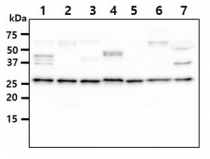ARG56961
anti-FADD antibody [J1D2]
anti-FADD antibody [J1D2] for IHC-Formalin-fixed paraffin-embedded sections,Western blot and Human
Overview
| Product Description | Mouse Monoclonal antibody [J1D2] recognizes FADD |
|---|---|
| Tested Reactivity | Hu |
| Tested Application | IHC-P, WB |
| Host | Mouse |
| Clonality | Monoclonal |
| Clone | J1D2 |
| Isotype | IgG2b, kappa |
| Target Name | FADD |
| Antigen Species | Human |
| Immunogen | Recombinant fragment around aa. 1-208 of Human FADD. |
| Conjugation | Un-conjugated |
| Alternate Names | Mediator of receptor induced toxicity; MORT1; GIG3; FAS-associated death domain protein; Growth-inhibiting gene 3 protein; Protein FADD; FAS-associating death domain-containing protein |
Application Instructions
| Application Suggestion |
|
||||||
|---|---|---|---|---|---|---|---|
| Application Note | IHC-P: Antigen Retrieval: Boil tissue section in 0.1M Sodium citrate buffer (pH 6.0) for 20 min. * The dilutions indicate recommended starting dilutions and the optimal dilutions or concentrations should be determined by the scientist. |
Properties
| Form | Liquid |
|---|---|
| Purification | Purification with Protein G. |
| Buffer | PBS (pH 7.4), 0.02% Sodium azide and 10% Glycerol. |
| Preservative | 0.02% Sodium azide |
| Stabilizer | 10% Glycerol |
| Concentration | 1 mg/ml |
| Storage Instruction | For continuous use, store undiluted antibody at 2-8°C for up to a week. For long-term storage, aliquot and store at -20°C. Storage in frost free freezers is not recommended. Avoid repeated freeze/thaw cycles. Suggest spin the vial prior to opening. The antibody solution should be gently mixed before use. |
| Note | For laboratory research only, not for drug, diagnostic or other use. |
Bioinformation
| Database Links |
Swiss-port # Q13158 Human FAS-associated death domain protein |
|---|---|
| Gene Symbol | FADD |
| Gene Full Name | Fas (TNFRSF6)-associated via death domain |
| Background | The protein encoded by this gene is an adaptor molecule that interacts with various cell surface receptors and mediates cell apoptotic signals. Through its C-terminal death domain, this protein can be recruited by TNFRSF6/Fas-receptor, tumor necrosis factor receptor, TNFRSF25, and TNFSF10/TRAIL-receptor, and thus it participates in the death signaling initiated by these receptors. Interaction of this protein with the receptors unmasks the N-terminal effector domain of this protein, which allows it to recruit caspase-8, and thereby activate the cysteine protease cascade. Knockout studies in mice also suggest the importance of this protein in early T cell development. [provided by RefSeq, Jul 2008] |
| Function | Apoptotic adaptor molecule that recruits caspase-8 or caspase-10 to the activated Fas (CD95) or TNFR-1 receptors. The resulting aggregate called the death-inducing signaling complex (DISC) performs caspase-8 proteolytic activation. Active caspase-8 initiates the subsequent cascade of caspases mediating apoptosis. Involved in interferon-mediated antiviral immune response, playing a role in the positive regulation of interferon signaling. [UniProt] |
| Calculated MW | 23 kDa |
Images (3) Click the Picture to Zoom In
-
ARG56961 anti-FADD antibody [J1D2] IHC-P image
Immunohistochemistry: Paraffin embedded sections of Human breast cancer tissue stained with ARG56961 anti-FADD antibody [J1D2] at 1:50 for 2 hours at RT. Antigen Retrieval: Boil tissue section in 0.1M Sodium citrate buffer (pH 6.0) for 20 min.
-
ARG56961 anti-FADD antibody [J1D2] WB image
Western blot: 30 µg of Jurkat stained with ARG56961 anti-FADD antibody [J1D2] at 1:500.
-
ARG56961 anti-FADD antibody [J1D2] WB image
Western blot: 40 µg of 1) HeLa cell lysate, 2) Raw264.7 cell lysate, 3) MCF7 cell lysate, 4) A431 cell lysate, 5) Ramos cell lysate, 6) Raji cell lysate, 7) Balb/3T3 cell lysate stained with ARG56961 anti-FADD antibody [J1D2] at 1:500.








